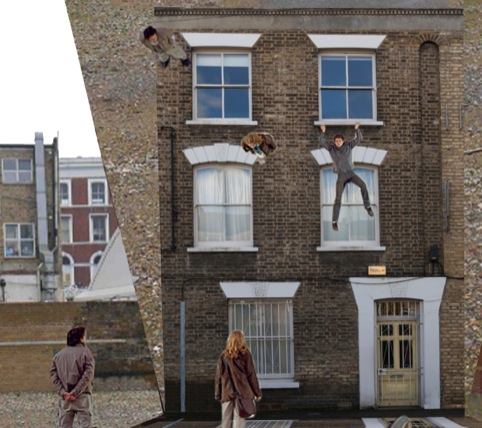A surreal, David Lynch-inspired design for Dalston House
Northeast London’s Dalston often takes on the feel of a slightly surreal like movie.

Source: Courtesy of Barbican Art Gallery
Leandro Erlich, Study for Dalston House installation 2013
Its heady mix of rugged East End charm, the distinctly olfactory Ridley Road market (which made headlines last year for its rat scandal…), artists, wide-eyed trustafarians and impossibly beautiful sartorialists make for a frequently bizarre atmosphere.
The area’s oddities look to be compounded further later this month, with the arrival of the Barbican’s latest off-site commission.
Dalston House, by Argentine artist Leandro Erlich, is taking over a space near Dalston Junction with a life-sized façade of a late-19th-Century Victorian terraced house.
In a confusing twist, the façade will lie flat on the ground, overshadowed by a mirrored surface. The mirror is at a 45-degree angle, meaning that when visitors lie, sit or stand on the ‘façade’ it appears that they are climbing up or hanging from the building.
The piece has been created in the style of the houses that would have previously stood at the site, just off Dalston Lane, with windows, doors and other architectural features recalling bygone days when the formerly ‘suburban village’ area was slowly becoming more urbanised, according to British History.

Source: © Leandro Erlich Courtesy of the Artist and Sean Kelly Gallery, New York
Leandro ErlichLa Torre, 2007
The overall effect aims to play with the viewer’s notions of reality through its participatory, theatrical nature. Erlich cites his influences as including directors Alfred Hitchcock, David Lynch, Luis Buñuel and Roman Polanski, who the artist says ‘have used the everyday as a stage for creating a fictional world obtained through the psychological subversion of everyday spaces.’

Source: © Leandro Erlich Photography: Matthew Septimus Courtesy: Sean Kelly Gallery, New York
Leandro ErlichSwimming Pool, 2008installation view at MoMA PS1, New York
The area’s Victorian terraced houses were destroyed by Second World War bombing, and it has since remained largely vacant.
Its location, tucked far enough away from the frenetic bustle of Kingsland Road to feel comparatively tranquil, makes it perfect for such installations, as proven by another Barbican project in 2009 which saw the site host the wonderful Dalston Mill.
Created by French artists EXYZT, it featured a live working flour mill, producing bready Dalston ‘currency’ that – much like the – could be used in shops, cafes and other outlets in area.

Source: Courtesy of Barbican Art Gallery
Leandro Erlich, Study for Dalston House installation 2013
The Dalston House installation will be accompanied by a series of events, performance and film screenings exploring themes including architectural history, urbanism, and perception, which are developed in collaboration with local organisations. For more information visit barbican.org.uk/beyondbarbican
Leandro Erlich: Dalston House runs from 26 June – 4 August at 1–7 Ashwin Street, Dalston, London E8

Source: © Leandro Erlich Photography: Leandro Erlich Courtesy: Leandro Erlich / Sean Kelly, New York
Leandro ErlichBatiment, 2004Installation: La Nuit Blanche, Paris, 2004
-
Post a comment




